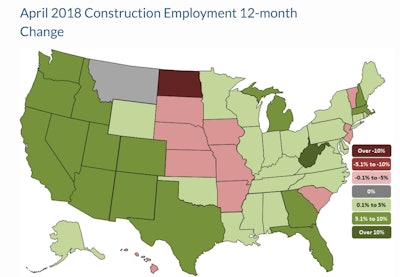
Thirty-eight states and the District of Columbia added construction jobs between April 2017 and April 2018, while 29 states added construction jobs between March and April, according to an Associated General Contractors of America analysis of Labor Department data. Association officials said the employment growth likely would have been higher if firms could find more qualified workers to hire.
“Firms in many parts of the country are working to keep pace with growing demand for construction services,” said chief economist Ken Simonson. “Many of those firms are having a hard time finding and hiring enough qualified workers as the pool of available workers remains very tight.”
California added the most construction jobs (59,500 jobs, 7.4%) during the past year. Other states adding a large number of new construction jobs for the past 12 months include:
- Texas (40,600 jobs, 5.7%)
- Florida (34,900 jobs, 7%)
- Georgia (13,900 jobs, 7.6%)
- Arizona (11,700 jobs, 8.2%)
West Virginia (11.6%, 3,500 jobs) added the highest percentage of new construction jobs during the past year, followed by:
- Nevada (9.8 percent, 8,200 jobs)
- Arizona
- Utah (8.1%, 7,700 jobs)
- Idaho (7.9%, 3,500 jobs)
Eleven states shed construction jobs between April 2017 and April 2018 while construction employment was unchanged in Montana. North Dakota lost the highest total and percentage of construction jobs (-4,900 jobs, -17%), followed by:
- Iowa (-2,500 jobs, -3.2%)
- Missouri (-1,500 jobs, -1.2%)
- South Carolina (-1,400 jobs, -1.4%)
- Nebraska (-1,100 jobs, -2.1%)
In addition to North Dakota, other states that lost a high percentage of construction jobs for the month included South Dakota (-3.%, -800 jobs); Iowa; Nebraska and Hawaii (-1.9%, -700 jobs).
Twenty-nine states added construction jobs between March and April. California added the most (10,000 jobs, 1.2%), followed by:
- Texas (4,100 jobs, 0.6%)
- Louisiana (2,200 jobs, 1.5%)
- Georgia (2,100 jobs, 1.1%)
- Washington (2,100 jobs, 1%)
Louisiana added the highest percentage of construction jobs for the month, followed by:
- Kentucky (1.4%, 1,100 jobs)
- New Hampshire (1.4%, 400 jobs)
- Alaska (1.3%, 200 jobs)
- Vermont (1.3%, 200 jobs)
Employment set an all-time high in Texas.
Nineteen states lost construction jobs from March to April, while construction employment was unchanged in Mississippi, Montana and the District of Columbia. Indiana lost the most construction jobs for the month (-2,300 jobs, -1.6%), followed by:
- Wisconsin (-2,000 jobs, -1.6%)
- South Carolina (-1,300 jobs, -1.3%)
- Massachusetts (-1,300 jobs, -0.8%)
- Michigan (-1,100 jobs, -0.6%)
North Dakota lost the highest percentage of construction jobs (-2.8%, -700 jobs), followed by:
- Delaware (-1.7%, -400 jobs)
- Wisconsin
- Indiana
- South Carolina
- South Dakota (-1.3%, -300 jobs).
Association officials said strong demand, particularly from the private-sector, was prompting firms in most states to add staff. But they cautioned that relatively few young workers appear to be entering the construction industry. They said the strong economy was increasing competition for most workers and construction recruiting is hampered by the fact relatively few schools offer instruction in construction skills or counsel students to consider high-paying construction careers.
“The collective cultural fixation on urging every student to go to college and seek office jobs means relatively few young adults are ever encouraged to consider careers in construction,” said Stephen E. Sandherr, the association’s chief executive officer. View the state employment data by rank, state, and peak.



















